The Commercial Pizza Oven Buyers Guide 2025
Commercial Pizza Oven Pricing Guide 2025
Before you bid on a $5,000 deck oven or a $2,000 conveyor, ask yourself one question: Are you building a business on volume and consistency, or specialization and quality? Analysis of 320 pizza oven sales reveals the fundamental choice that drives equipment decisions, pricing, and profitability.
The Business Model Question That Drives Everything
Every pizza operation faces a fundamental fork in the road. Not a question of budget or location or menu—though those matter. The essential choice is this: Will you monetize through volume and consistency, or through specialization and quality?
This isn't philosophical. This decision determines your equipment, your staffing, your ingredient costs, your prep schedule, and ultimately whether you're competing with Domino's or showcasing craft in an open kitchen. The wrong equipment choice—even purchased at excellent auction pricing—becomes an expensive mistake when it doesn't match your business model.
Analysis of 320 commercial pizza oven sales over the past year reveals pricing patterns that reflect this divide. Conveyor ovens command a median price of $1,022—five times higher than the $198 median for all oven types. Deck ovens cluster around $700 median for single-deck units. Wood-fired craft installations reach $4,350 median. These aren't arbitrary numbers. They represent different revenue models, different operational commitments, and different paths to profitability.
- Median sale price across all types: $198.50
- Mean sale price: $999.54 (elevated by premium craft installations)
- Price range: $0.01 to $16,800
- Conveyor ovens: $1,022 median (68 sales)
- Single deck ovens: $700 median (88 sales)
- Wood-fired craft: $4,175 median (4 sales)
Understanding which path you're on—or should be on—determines equipment success. Let's examine both routes with the operational reality that drives pricing.
Path One: Volume and Consistency Through Conveyor Systems
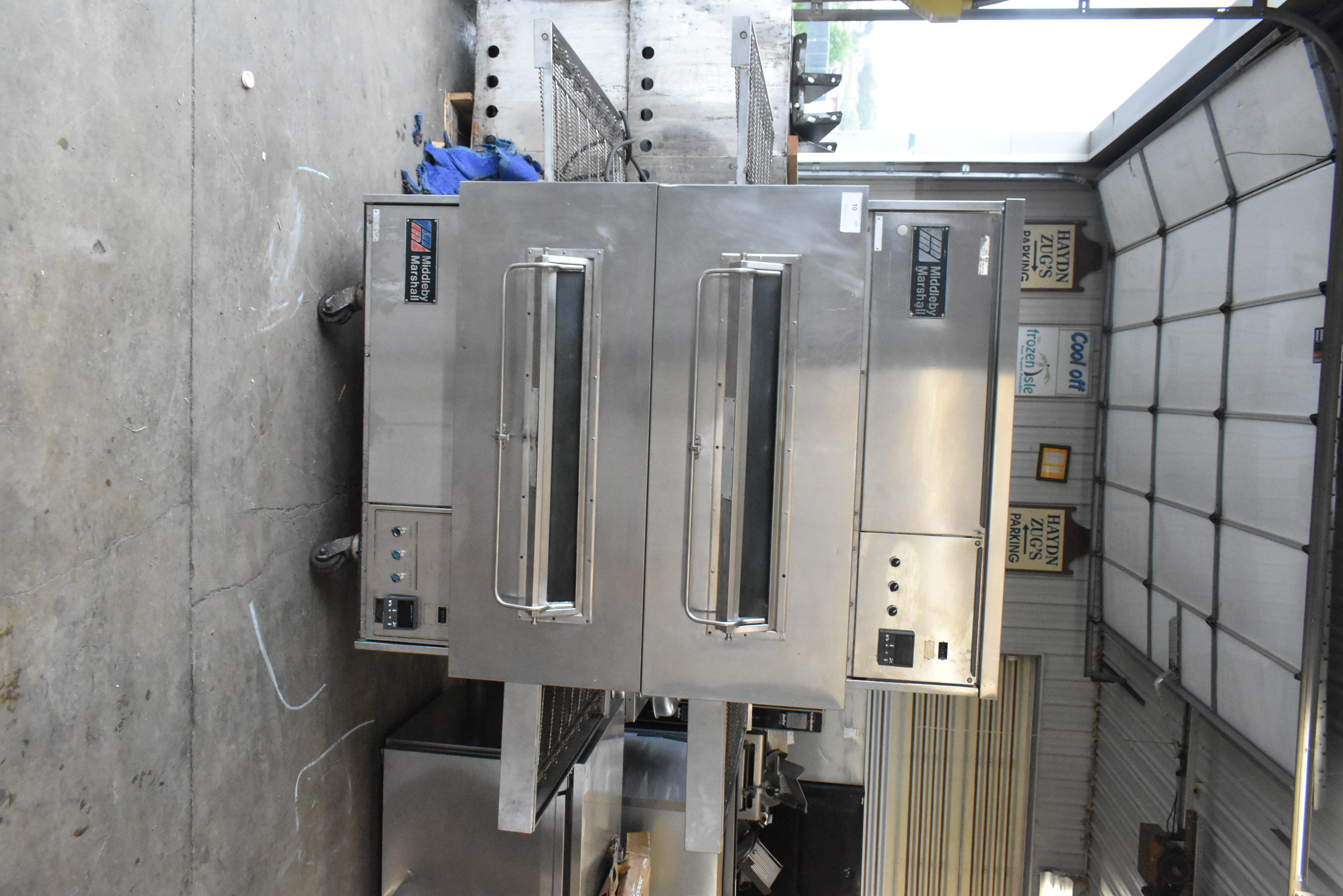
Conveyor ovens—also called impinger ovens—represent the operational model that built Pizza Hut, Domino's, Little Caesars, and every major pizza buffet operation. These machines don't require specialized training. They don't need recovery time between pizzas. They eliminate the skill barrier entirely.
How Conveyor Economics Work
The system is elegantly simple: dial in time and temperature for optimized results, then load pizzas as fast as you can reload the conveyor belt. No pizza peel required—raw dough goes on a screen that lifts off the belt when cooking completes. Additional pizzas being cooked don't change interior cavity temperature appreciably or slow throughput. The machine just keeps cranking them out.
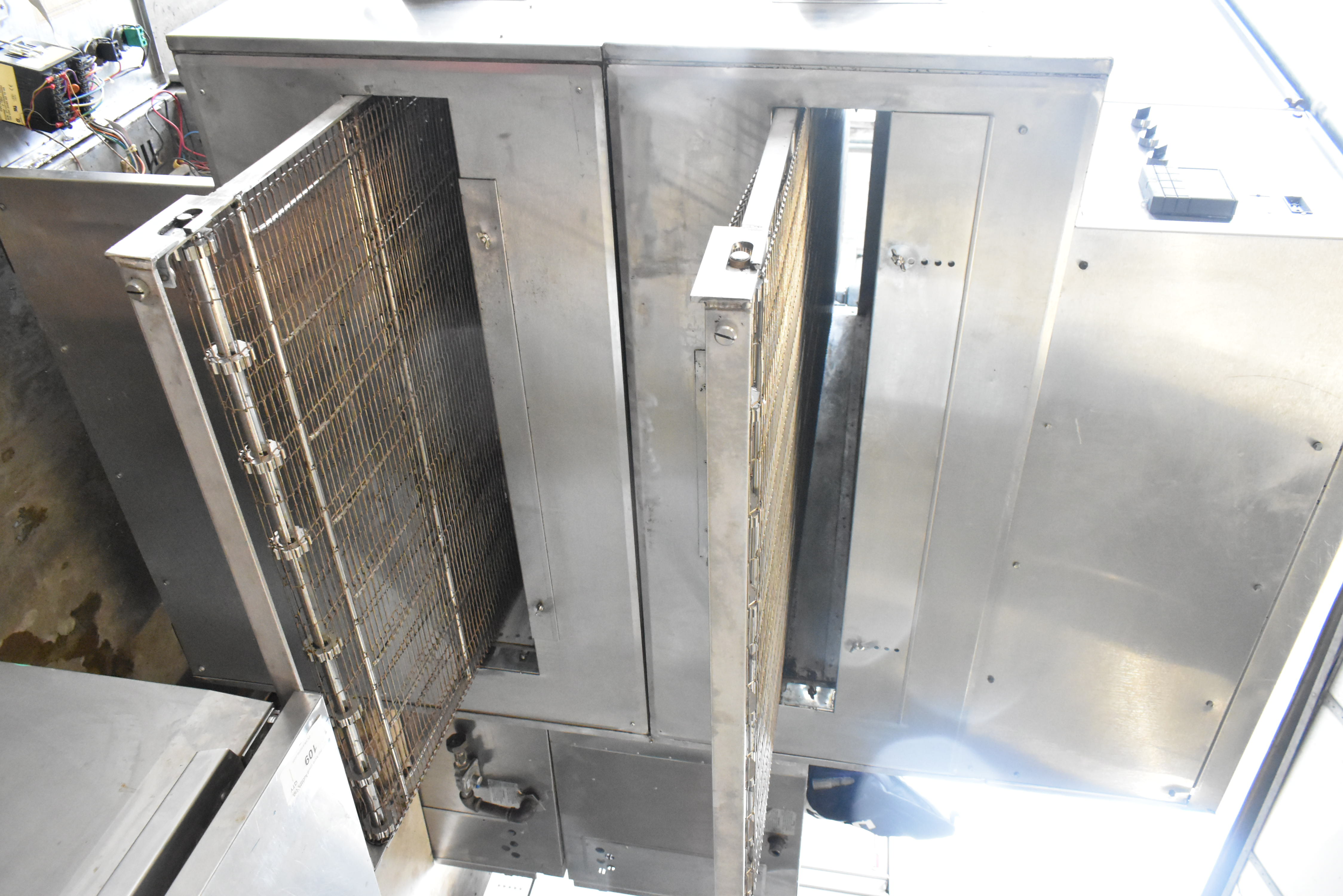
This operational simplicity delivers massive advantages:
- No skill requirement: Training takes minutes, not months. Any employee can operate consistently.
- Consistent output: Every pizza receives identical cook time and temperature. Quality variance approaches zero.
- Maximum throughput: No waiting for stone temperature recovery. Continuous operation during rush periods.
- Predictable labor costs: Minimal training investment, lower skill requirements, less specialized staffing needed.
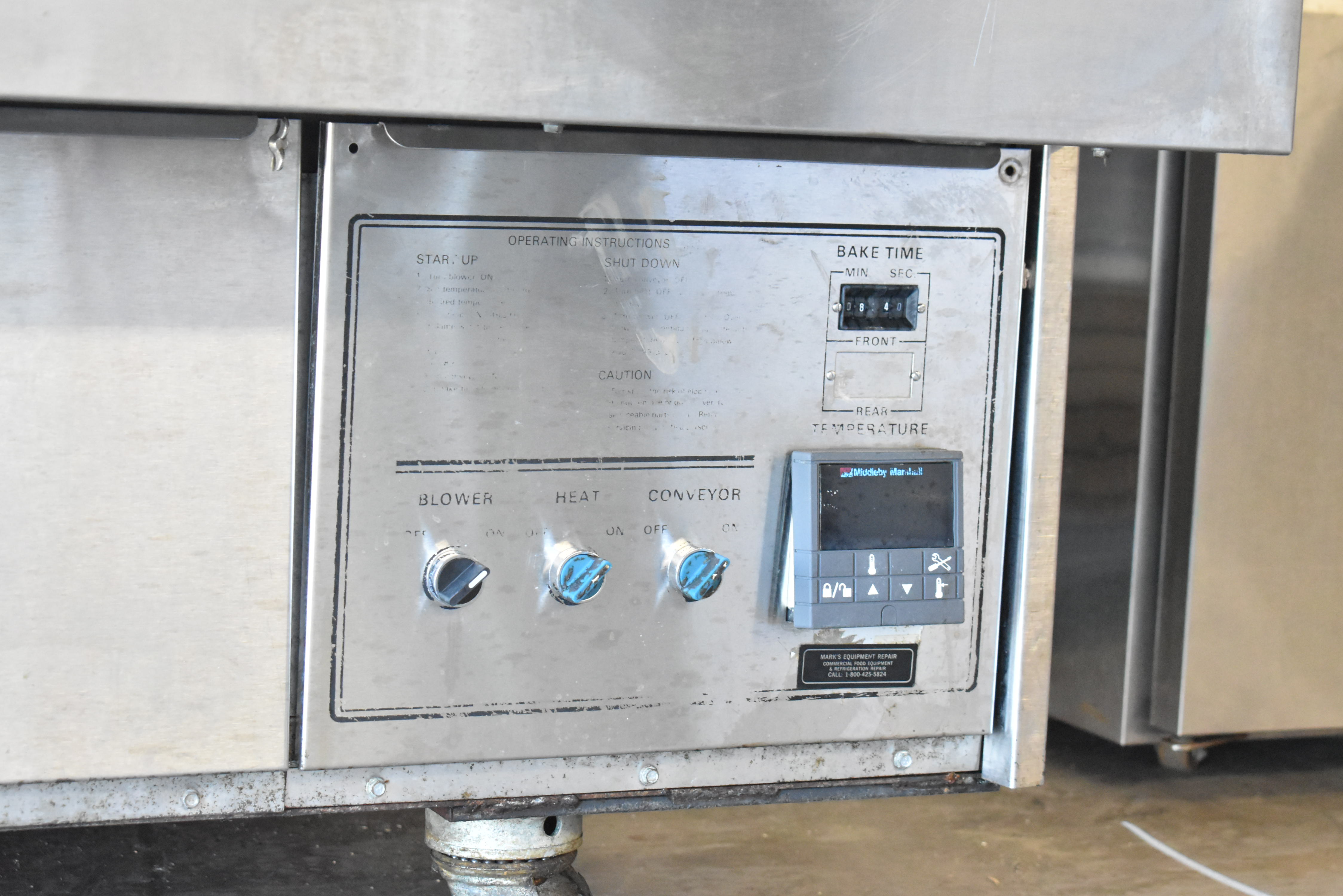
- Middleby Marshall: 28 units sold, $1,875 median, range $2-$9,700
- Lincoln Impinger: 16 units sold, $661 median, range $6-$5,500
- CPG (Cooking Performance Group): 11 units sold, $826 median
Top conveyor sale: Middleby Marshall PS840GVE2 (x2) at $9,700
The Conveyor Business Model
If your business plan includes:
- Delivery-focused operations competing on speed and reliability
- High-volume buffet service requiring consistent output
- Multiple locations requiring operational standardization
- Limited staff training time and budget
- Premade crusts or simplified ingredient systems
- Competitive pricing requiring tight labor cost control
Then conveyor ovens match your revenue model. There's no shame in this choice. Major industry players use impingers because they make damn fine pizza. The consistency and throughput enable business models that dominate market share through volume and reliability.
Path Two: Craft and Differentiation Through Deck Ovens
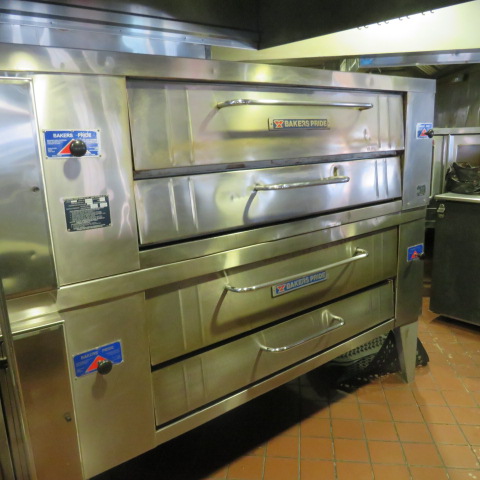
Deck ovens represent the traditional pizzeria model. Wood, gas, or electric heat source. Pizza stones that require regular careful upkeep. Cooking surfaces that need time to recover temperature after removing a cooked pizza. Skills that take time to develop—dropping raw dough onto hot stones and retrieving finished pies without disasters.
Reading that description, deck ovens sound like nothing but disadvantages compared to conveyor efficiency. Why would anyone choose this path?
Because the crust tastes better.

What Deck Ovens Deliver That Conveyors Cannot
The pizza produced on high-temperature deck ovens with quality stones delivers bigger flavors, more dynamic texture, and authentic experience that no conveyor—even the sophisticated Middleby Marshall units—can match. The craftsmanship and skill required to operate deck ovens successfully comes through in the end result. Customers taste the difference.
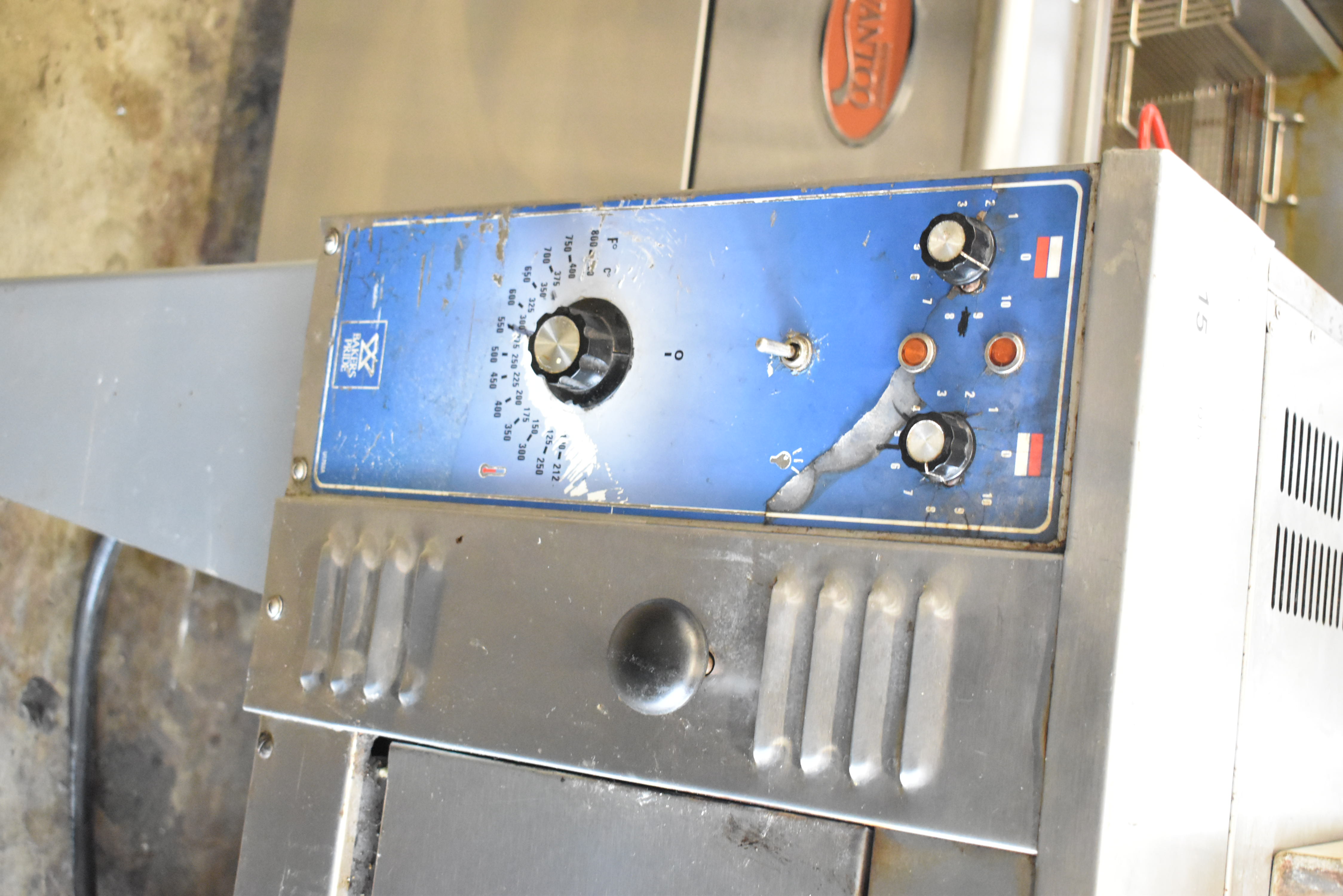
But this quality comes with significant operational commitments:
- 4:30 AM dough prep: Fresh dough balls need time to proof. You can't rush yeast activation for craft pizza.
- Equipment investment: Hobart 60Q planetary mixer (preferred for pizza dough), quality ingredients that complement rather than overpower your dough recipe.
- Staff training requirements: Prep workflow, service operation, equipment maintenance—all require skilled labor.
- Stone maintenance: Regular cleaning, careful handling, eventual replacement of cracked or damaged stones.
- Temperature management: Understanding recovery times, heat distribution, optimal loading patterns.
- Bakers Pride: 41 units sold, $700 median, range $1.75-$8,200
- Blodgett: 26 units sold, $451 median, range $9.88-$2,100
- Montague: 2 units sold, $546 median
Top deck sale: Bakers Pride Y600 (x2) at $8,200
The Deck Oven Business Model
The commitment to craft creates differentiation that justifies premium positioning:
- Independent pizzerias competing on quality and authenticity
- Open kitchen concepts showcasing craft and skill
- Operations willing to invest in fresh dough workflows
- Businesses positioned for higher price points through superior product
- Locations with trained kitchen staff capable of mastering technique
The Fundamental Question
Do you have passion for 4:30 AM dough prep? Are you committed to sourcing quality ingredients? Will you invest in staff training for prep, service, and equipment maintenance? Can you monitor every aspect of the workflow including oven performance?
If yes: Deck ovens enable you to make the best pizza in the world when executed correctly.
If no: Conveyor ovens deliver excellent results without operational complexity. There's no wrong answer—only mismatched equipment and business models.
The Craft Tier: When Quality Becomes Non-Negotiable
Wood Stone: The Open Kitchen Statement
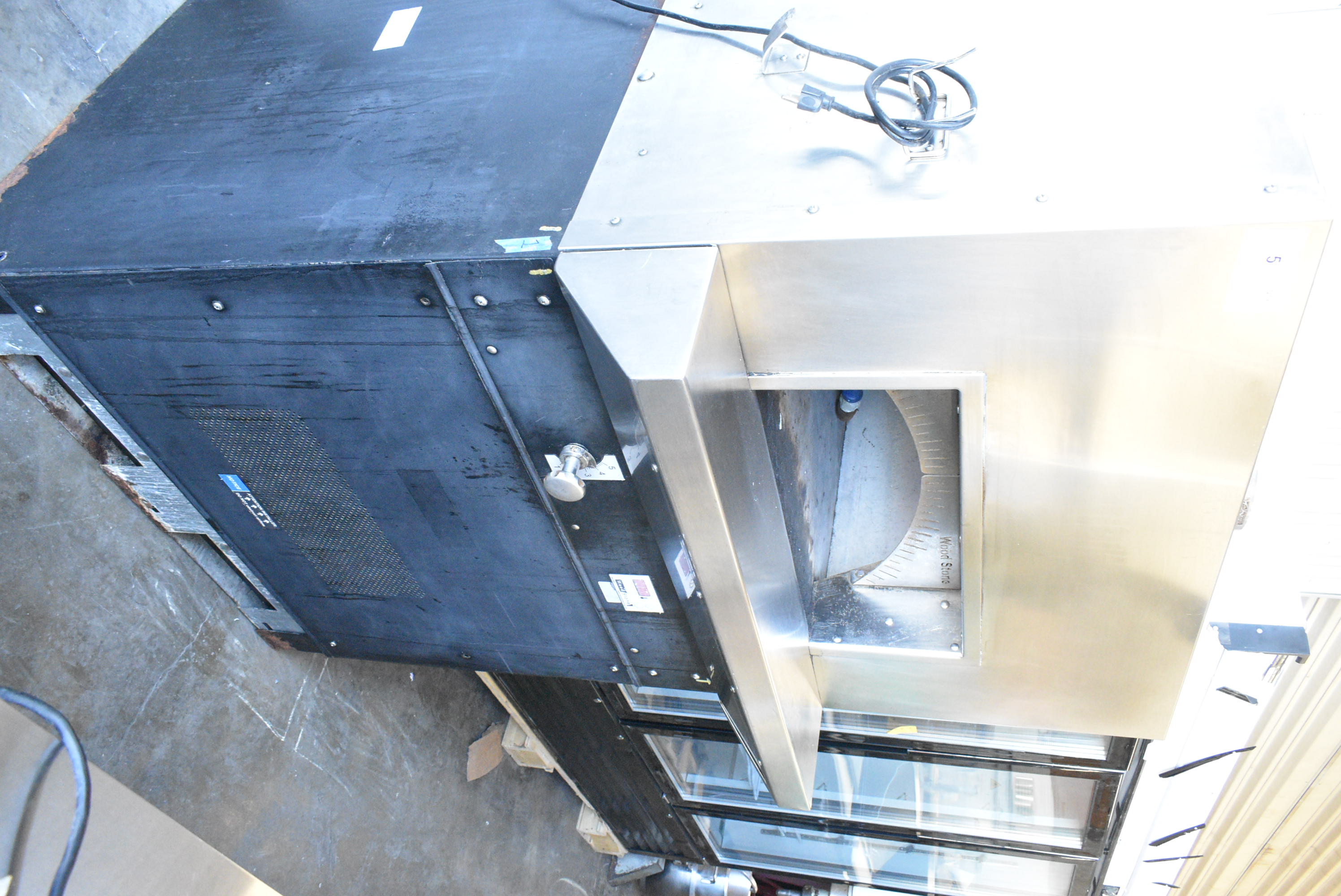
Wood Stone ovens command $4,350 median auction pricing for a reason. These brilliantly engineered pizza ovens—despite the name, not all are wood-fired; many use gas or combination heating—deliver intelligent cavity design, superior heat retention, and build quality that announces commitment to craft.
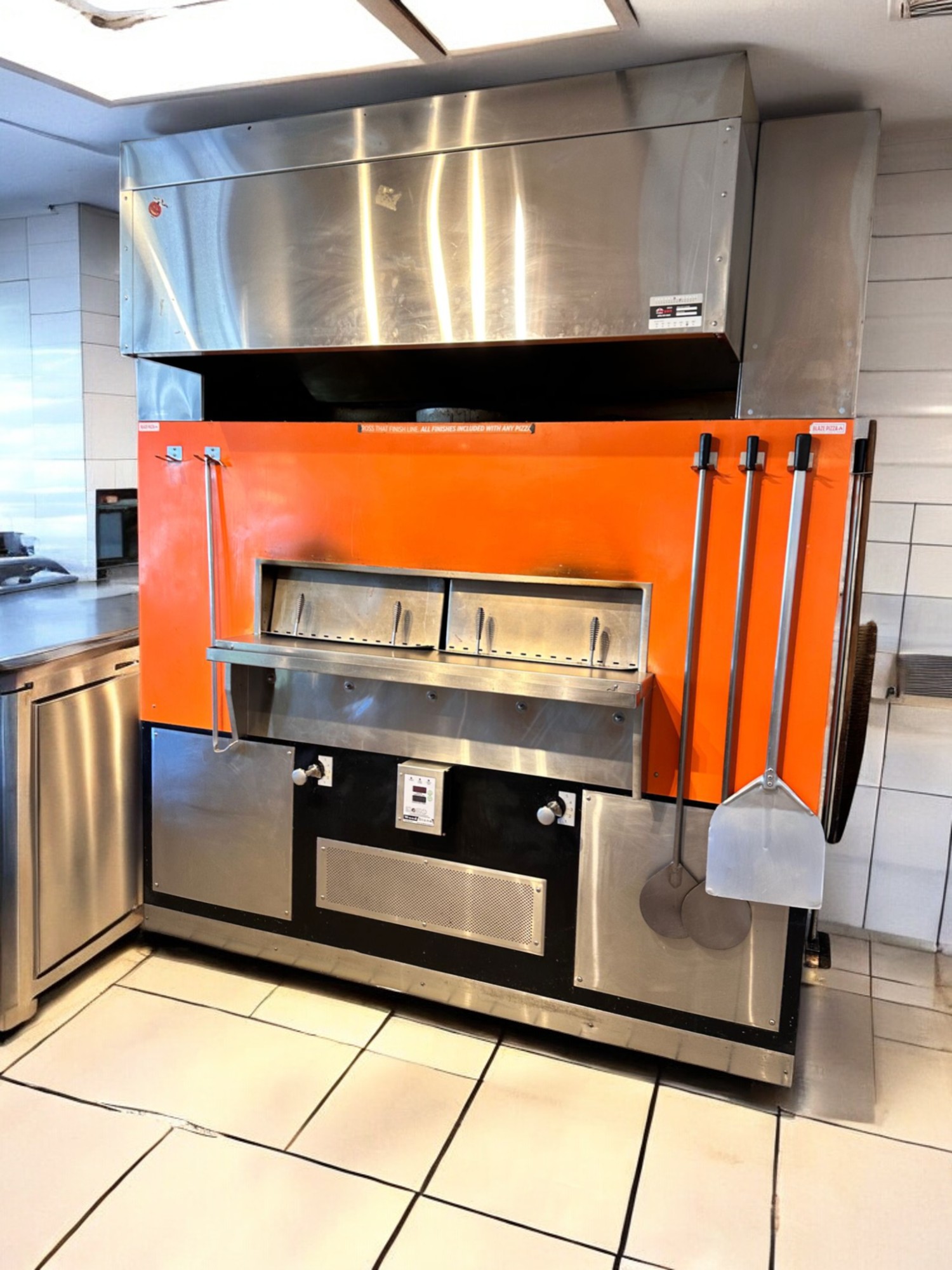
With open kitchen concepts gaining momentum across the restaurant industry, the oven becomes visible statement. Wood Stone installations demonstrate pride in product in the same way a Moretti Forni Italian oven would. The equipment shows care taken with each pizza and willingness to invest in customer satisfaction. This is powerful messaging.

- 4 units sold over past year
- $4,350 median price
- Range: $3,000 to $4,500
- Retail comparison: $15,000-$25,000+ for new installations
The European Elite: When Competition Demands Perfection
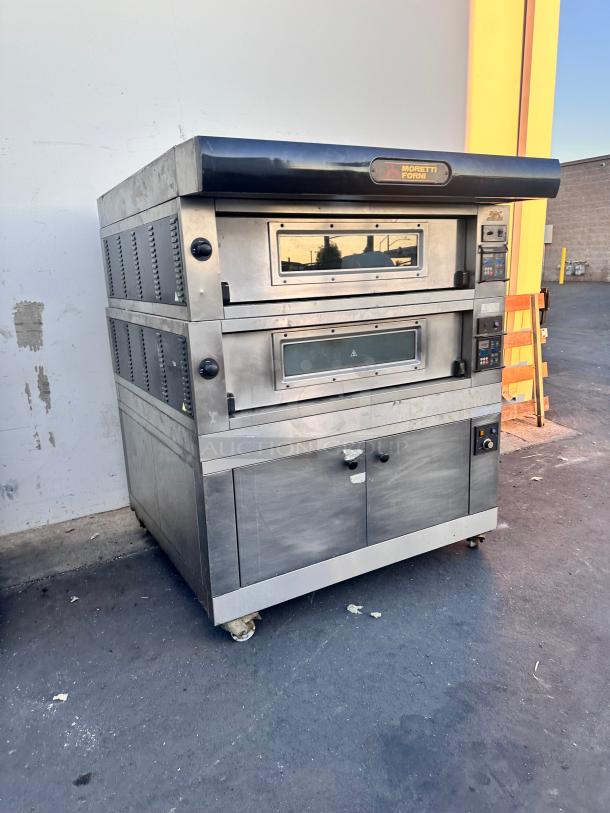
Moretti Forni. Salva. Marsal. Europa. These aren't just oven manufacturers—they're Italian craftsmen who have done nothing else for 125 years. Just pizza ovens. Generation after generation of engineering refinement focused on one goal: the perfect pizza.

Who needs this level of equipment? Operators committed to the complete workflow:
- Water: Tested and optimized
- Yeast: Precisely balanced with perfect activation temperature
- Pizza makers: Trained in authentic technique
- Mixer: Hobart planetary for proper dough development
- Cheese: Imported whole, grated same day
- Sauce: Homemade from San Marzano tomatoes
- Shortcuts: None

What's left after perfecting every other element? The oven itself. And when competition is fierce and quality is non-negotiable, European craft ovens represent the final piece. Not that you can't make amazing pizza without them—but when your entire operation pursues excellence, equipment becomes an extension of that commitment.
- Highest sale: Salva 2013 NXE (x3) at $16,800
- Marsal: SD448 (x2) at $12,000
- Salva vapor: NXE-20 VAPOR (x3) at $8,700
- Europa: E2L 18PA (x4) at $5,400
These premium brands command prices approaching or exceeding typical auction maximums—because buyers recognize the quality difference.
The Menu Multiplier: Countertop Pizza Ovens
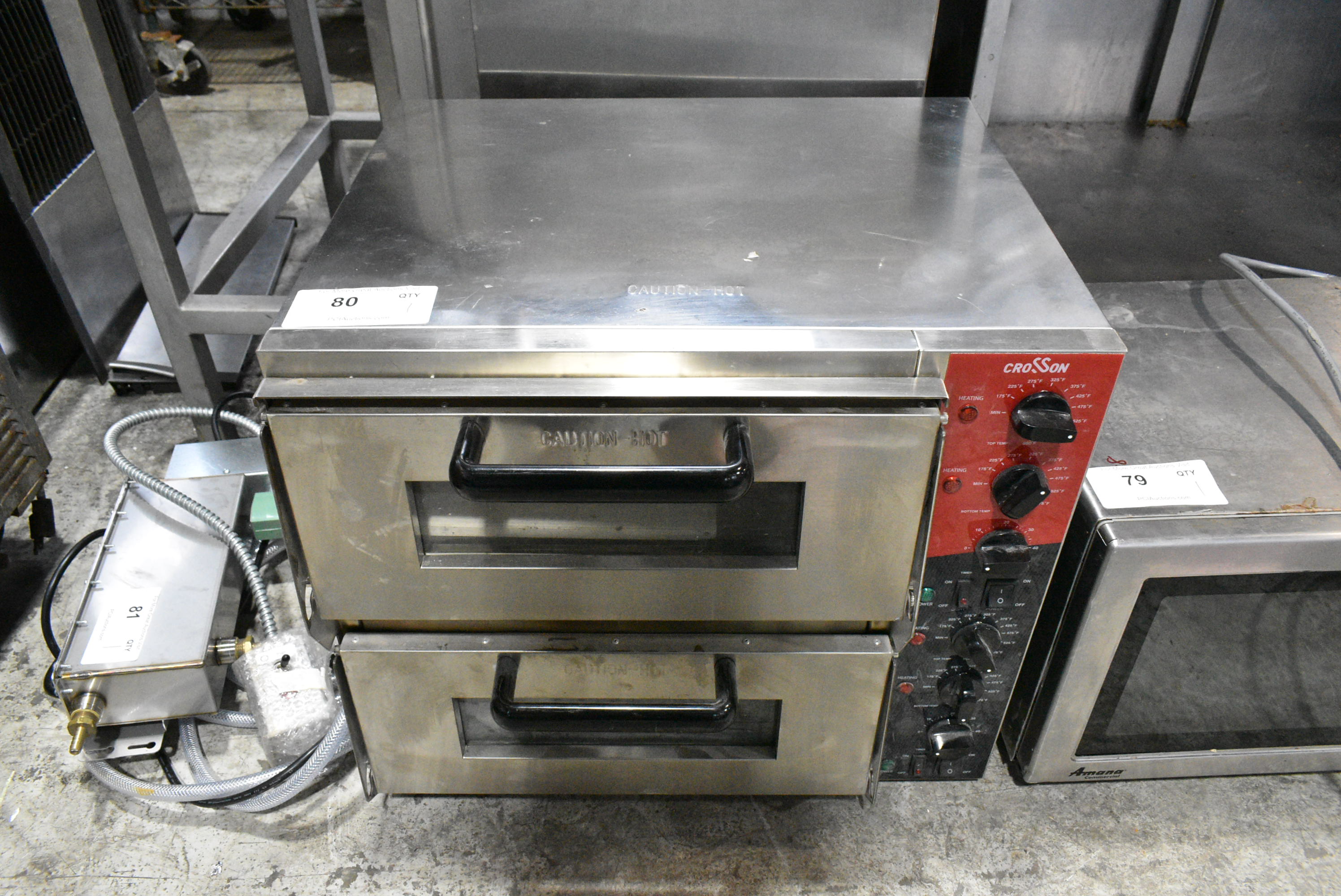
Not every operation needs full-scale pizza production. Gas stations, convenience stores, smaller cafes—these businesses want to add pizza or toasted sandwiches to their menu without committing space, budget, or operational complexity to pizza-centric models.
Countertop pizza ovens solve this exact problem. Sheetz, Wawa, and similar quick-service operations use compact electri units for grab-and-go pizzas. Small cafes deploy them for lunchtime paninis and personal pizzas. These units deliver superior results to traditional gas ovens without stones, requiring minimal space and operational investment.
- Crosson: 58 units sold, $55.50 median (market leader by volume)
- Wisco: 9 units sold, $22 median
- Overall countertop category: $50 median across 70 sales
The massive volume at ultra-low pricing reflects specific use cases: menu expansion without full pizzeria commitment.
The strategic value isn't about making the best pizza—it's about menu multiplication. A cafe serving breakfast sandwiches and lunch salads can add personal pizzas, toasted subs, and hot pressed sandwiches with a $500 investment (at auction pricing). The equipment pays for itself in weeks if executed well.
Market Analysis: 320 Sales Reveal Price Tiers
Analysis of 320 commercial pizza oven sales over the past year establishes clear value tiers corresponding to equipment types, brand positioning, and operational capabilities.
Overall Market Statistics
| Metric | Value |
|---|---|
| Total sales analyzed | 320 units |
| Median price | $198.50 |
| Mean price | $999.54 |
| Price range | $0.01 - $16,800 |
| 25th percentile | $50 |
| 75th percentile | $1,012.50 |
Brand Value Hierarchy
| Brand | Units Sold | Median Price | Range |
|---|---|---|---|
| Wood Stone | 4 | $4,350 | $3,000 - $4,500 |
| Middleby Marshall | 28 | $1,875 | $2 - $9,700 |
| CPG | 11 | $826 | $0.01 - $2,000 |
| Bakers Pride | 41 | $700 | $1.75 - $8,200 |
| Lincoln | 16 | $661 | $6 - $5,500 |
| Montague | 2 | $546 | $42 - $1,050 |
| Blodgett | 26 | $451 | $9.88 - $2,100 |
| Other (includes premium European) | 121 | $130 | $0.01 - $16,800 |
| Crosson | 58 | $55.50 | $6 - $475 |
| Wisco | 9 | $22 | $6 - $45 |
Oven Type Economics
| Oven Type | Units Sold | Median Price | Primary Use Case |
|---|---|---|---|
| Wood-Fired Craft | 4 | $4,175 | Artisan pizzerias, open kitchen showcases |
| Conveyor | 68 | $1,022.50 | High-volume operations, delivery chains |
| Single Deck | 88 | $700 | Independent pizzerias, craft operations |
| Double Deck | 54 | $113.51 | Space-efficient deck installations |
| Countertop | 70 | $50 | Convenience stores, cafes, menu expansion |
The Double Deck Paradox Explained
Double deck ovens show surprisingly low median pricing ($113) compared to single deck units ($700). This isn't market preference—it's extraction condition reality.
Double deck units typically arrive as consignments from closed restaurants, often removed without proper care. This means broken stones, chassis damage, and other value hits that depress auction pricing. The segment isn't less desirable—the available inventory just reflects rough handling during removal.
Fuel Type Economics: Why Gas Dominates
Electric pizza ovens exist. You can find them at auction. But gas-powered units represent the overwhelming majority of commercial pizza oven sales for practical reasons that affect both pricing and operational success.
The Infrastructure Reality
Commercial kitchens are significantly more likely to have gas lines already installed than 240V three-phase electrical service. This infrastructure advantage makes gas ovens easier to install and more practical for most locations. The alternative—upgrading electrical service to accommodate electric ovens—often costs more than the equipment itself.
The Craft Hierarchy
Within pizza circles, fuel type carries quality associations:
- Wood: Requires genuine skill to maintain consistent temperature and avoid over/under-cooking. Authenticpizzeria tradition. Highest craft credibility.
- Gas: Easier temperature management than wood, faster startup than electric, consistent heating. Industry standard for quality operations.
- Electric: Slowest to reach operating temperature, less responsive to adjustments. Functional but not preferred for serious operations.
This hierarchy matters less for conveyor ovens where precise computer control manages heating regardless of fuel source. But for deck ovens pursuing craft positioning, gas delivers operational advantages that justify market preference.
Performance Considerations
Gas-powered ovens reach operating temperature faster during startup—critical for morning prep schedules. Some units maintain more consistent heating under load, though modern electric ovens have largely eliminated this gap. The real advantage remains infrastructure compatibility and industry preference.
The Mobile Pizza Challenge
Food trucks and mobile kitchens dominate certain segments—BBQ, tacos, burgers, even fried foods. But mobile pizza operations remain surprisingly rare. The engineering challenges explain why.
The Heat Problem
Craft deck ovens operate at 900-1,400°F interior temperatures. Inside a truck or trailer? That's a dangerous, uncomfortable, potentially catastrophic environment. The heat radiates into the limited space, making working conditions unbearable and creating fire safety concerns.
Conveyor ovens run cooler but still generate significant heat. With open conveyor belts continuously cycling, they heat the environment constantly. Plus, quality conveyor units like Middleby Marshall are large—occupying precious square footage in already-cramped mobile spaces.
The Volume Equation
Smaller conveyor units exist from brands like TurboChef, but they sacrifice the high-volume throughput that makes conveyors attractive. Compact countertop units work dimensionally but produce pizzas comparable to frozen supermarket brands. Where's the differentiation that justifies premium pricing?
Why Mobile Pizza Struggles
Personal experience: a friend ran a mobile pizza operation using converted Peerless ovens running LP with six pizza stones each. People loved the product. But setup and teardown became massive operational challenges. The heat management inside the trailer required constant attention. The workflow complexity multiplied compared to stationary operations.
The fundamental issue: how do you deliver craft quality or volume efficiency as a mobile concept when both equipment types face engineering limitations in confined spaces? Some operations undoubtedly find solutions, but the rarity of mobile pizza compared to other food truck concepts reflects these real challenges.
Scratch and Dent Opportunity: Premium Equipment at Auction Pricing

Brand new scratch and dent (BNSD) units represent exceptional value propositions at auction. These are cosmetically imperfect machines—dents, scratches, shipping damage—that remain fully functional with manufacturer specifications intact. Retail distributors cannot sell damaged equipment as new, so these units flow to auction where back-of-house buyers recognize the opportunity.
The Value Proposition
A dent on the side panel of a conveyor oven destined for a kitchen corner? Irrelevant. A scratch on a deck oven that will be positioned against a wall? Invisible. The cosmetic imperfection that prevents retail sale doesn't affect operational capability.
- Lincoln Impinger 1117 Series 1100 (BNSD) - $5,500 (retail $10,000+)
- CPG 351ICOED conveyor (BNSD) - $700 (retail $2,500+)
- Multiple Salva and Europa units (BNSD) - $5,000-$8,700 (retail $15,000-$25,000+)
The best part: no supply chain delays. These units are available for immediate pickup the day after auction closes. Compare this to new equipment orders with 6-12 week lead times and the value becomes even more compelling.
BNSD Strategy
Research retail pricing before bidding on BNSD units. Set your maximum bid at 40-50% of retail to maintain margin. These units typically attract strong bidding competition because the value is obvious—so discipline matters. Don't get caught in auction fever and bid past the value threshold.
Rigging, Moving, and Installation Reality
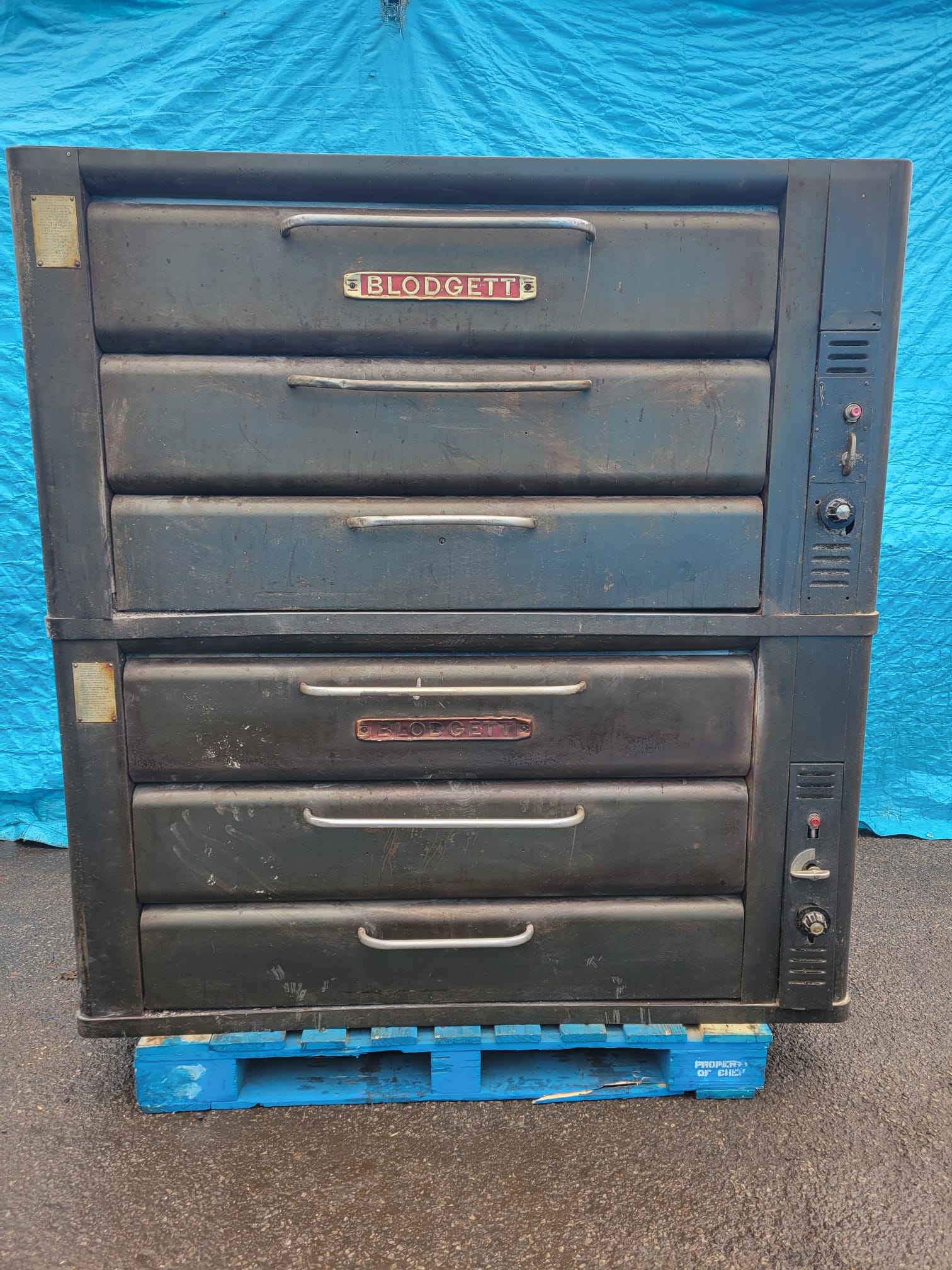
Pizza ovens are heavy, awkward, and contain fragile components. Professional handling during extraction and installation prevents damage that eliminates auction savings. Here's the operational reality of moving these machines.
At Auction Pickup
PCI Auctions provides forklift service to load purchased equipment onto your vehicle. The oven leaves our facility safely. The challenge begins when you need to position it inside your restaurant.
Pre-Move Preparation
Critical first step: Take photos of everything before disassembly. This creates your reassembly roadmap and prevents confusion later.
For Deck Ovens:
- Remove stones immediately: Wrap each stone individually in furniture blankets. Handle with extreme care—replacement costs $100-$300+ per stone.
- Strip removable components: Doors, control panels, gas valves, anything that unbolts easily. Reduces weight and protects delicate parts.
- Transportation position: Flip oven on its back for moving (protect gas line connections). This lowers center of gravity and allows doorway clearance.
- Multi-stack separation: Separate stacked units before attempting to position unless you have straight-shot access with ample clearance.
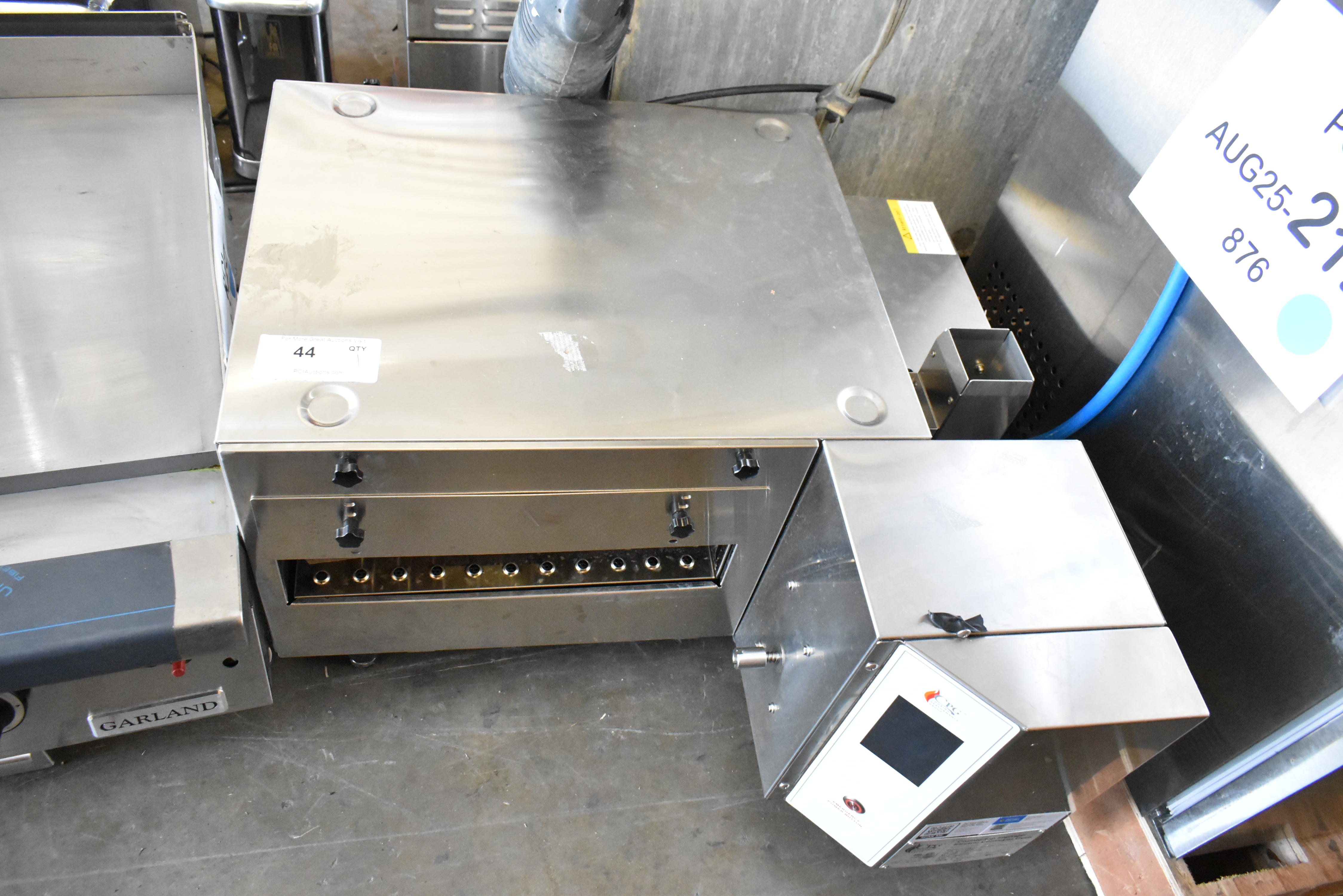
For Conveyor Ovens:
- Remove conveyor belt first: 100% removable in all units. This eliminates fragile components and reduces weight significantly.
- Strip interior components: Catch trays, candles (flame spreaders), jets, doors, exterior fascia—remove everything possible.
- Transportation method: Main cavity and control box assembly goes on furniture dollies sideways. This configuration rolls through most standard doorways.
- Weight consideration: Even after stripping components, conveyor units remain heavy. Use proper equipment—no manual lifting attempts.
Installation Positioning
Once inside your location, reverse the disassembly process using your photos as reference. Common mistakes:
- Forgetting to reconnect specific gas valves or electrical connections
- Installing conveyor belts backwards (check manufacturer markings)
- Positioning stones incorrectly in deck ovens (some have specific placement patterns)
- Over-tightening bolts during reassembly (causes thread damage)
Inspection Checklist Before Bidding
Pizza ovens sold at auction arrive untested in most cases. Gas units cannot be powered during preview for safety reasons. Electric units may be tested if infrastructure allows, but comprehensive functionality assessment remains impossible. Visual inspection becomes your primary evaluation tool.
Critical Inspection Points
For All Oven Types:
- Overall cleanliness: Clean interiors suggest proper operational care and maintenance. Heavily soiled cavities indicate neglect that may extend to mechanical components.
- Control panel condition: Check for cracked displays, non-responsive buttons, water damage, or burnt components. Control board replacements cost $500-$2,000.
- Exterior condition: Dents and scratches affect value but not function. Rust, severe corrosion, or structural damage indicates serious issues.
- Gas connections: Inspect lines for damage, corrosion, or amateur repair attempts. Replacement isn't expensive but adds to total investment.
- Electrical components: Look for burnt wiring, melted connectors, or obvious electrical damage. These repairs get expensive quickly.
Deck Oven Specific:
- Stone condition: Cracks, chips, or complete breaks. Replacement stones cost $100-$300+ each. Factor this into bidding.
- Door seals: Torn or missing seals affect heat retention. Replacement is inexpensive but indicates maintenance neglect.
- Burner condition: For gas units, inspect burners for damage or clogging. Clean burners are good signs.
Conveyor Oven Specific:
- Conveyor belt presence and condition: Missing belts aren't deal-breakers but add $300-$800 to total cost. Damaged belts need replacement.
- Drive system: Look for obvious damage to belt drive mechanisms, motors, or chain systems.
- Heating elements: Check for broken or disconnected elements. Difficult to assess without power but visible damage is concerning.
The Double Stack Consideration
Stacked ovens deliver space efficiency but complicate inspection. You can typically only assess the lower unit easily during preview. The upper unit remains partially obscured. This uncertainty should factor into bidding—either accept the risk or focus on single-unit installations.
Bidding Strategy by Equipment Type
Premium Craft Installations ($3,000+)
Target equipment: Wood Stone, European brands (Salva, Marsal, Moretti Forni, Europa), high-end conveyor systems
Strategy: Research retail pricing thoroughly. These units retail $15,000-$30,000+, making auction pricing at $3,000-$10,000 exceptional value even at the high end. Competition will be fierce because professionals recognize the opportunity. Set maximum bid at 50% of retail and stick to it. Don't chase into unprofitable territory.
Inspection priority: Overall condition matters less than functionality. Cosmetic wear is expected and won't affect operation. Focus on structural integrity and component completeness.
Commercial Core Equipment ($700-$2,000)
Target equipment: Middleby Marshall conveyors, Bakers Pride decks, Lincoln Impingers, Blodgett decks
Strategy: This tier represents reliable commercial equipment at reasonable pricing. Budget for potential minor repairs ($200-$500) when setting maximum bids. Clean units from closed restaurants typically perform well. Units showing heavy use may need component replacement but remain serviceable.
Inspection priority: Cleanliness correlates with functionality. Clean interiors suggest maintenance was performed. Broken stones, damaged belts, or minor issues are repairable—factor costs into bidding but don't eliminate otherwise solid units.
Entry Level Equipment ($200-$700)
Target equipment: Budget conveyors, single deck ovens, countertop units for main operations
Strategy: Expect unknown functionality. Units in this range come from various sources with inconsistent maintenance histories. Budget $500-$1,000 for potential repairs and service. Your total investment should remain under $1,500-$2,000 to maintain value proposition versus new equipment.
Inspection priority: Look for deal-breakers—major structural damage, obviously broken components, signs of fire or water damage. Minor issues are expected and acceptable if total investment remains reasonable.
Menu Expansion Equipment ($50-$200)
Target equipment: Crosson countertops, Wisco units, compact ovens for supplemental use
Strategy: These represent low-risk experiments. Even if functionality is limited, total investment remains minimal. Focus on complete units with all components present. Missing parts often cost more to replace than the equipment is worth.
Inspection priority: Completeness matters more than condition. Check for power cords, control knobs, interior racks or stones. These small components are frustrating to source after purchase.
The Discipline Requirement
Auction fever is real. Competitive bidding creates emotional investment that overrides rational pricing. Combat this by setting maximum bids before auction starts. Write them down. Commit to walking away when bidding exceeds your threshold. Another opportunity will appear next week—PCI runs 600-900 lots weekly including regular pizza oven inventory.
Final Assessment: Match Equipment to Business Model
The pizza oven market offers extraordinary value opportunities for operators who understand their business model first and equipment second. The fundamental question—volume and consistency versus specialization and quality—determines which equipment delivers profitability.
- 320 pizza oven sales analyzed over past year
- $198.50 overall median vs $3,000-$12,000+ typical retail
- Wood Stone craft installations: $4,350 median (82% below retail)
- Middleby Marshall conveyors: $1,875 median (70-80% below retail)
- Bakers Pride decks: $700 median (75-85% below retail)
- Countertop menu expanders: $50 median (90%+ below retail)
Decision Framework
Choose conveyor ovens if:
- Your business model emphasizes delivery, high volume, or consistent output
- Staff training time and budget are limited
- You plan to use premade crusts or simplified ingredient systems
- Multiple locations require operational standardization
- Labor cost control is critical to profitability
Choose deck ovens if:
- You're committed to fresh dough, quality ingredients, and craft positioning
- Your operation can support early morning prep schedules
- Staff training investment makes business sense
- Premium pricing justified by superior product is your model
- Differentiation through quality drives your competitive strategy
Choose craft installations (Wood Stone, European) if:
- Open kitchen concepts showcase your operation
- Equipment becomes marketing and differentiation
- Competition requires non-negotiable quality
- Your entire workflow pursues excellence
- Premium positioning justifies equipment investment
Choose countertop ovens if:
- Menu expansion without major commitment is your goal
- Convenience store or cafe applications fit your model
- Space and budget limit options
- Testing pizza viability before major investment makes sense
The Auction Advantage
Consistent supply through PCI Auctions' 600-900 weekly lots means equipment availability remains strong. Missing one auction doesn't eliminate future opportunities. This supply reality should inform bidding strategy—walking away from overpriced units makes sense when next week brings fresh inventory.
The key to auction success: understanding your business model, matching equipment to operational reality, and maintaining bidding discipline. Get these elements right and pizza oven auctions deliver exceptional value that transforms profitability versus retail equipment investments.
Ready to Bid on Commercial Pizza Ovens?
PCI Auctions offers 600-900 lots weekly including conveyor ovens, deck installations, craft systems, and countertop units. Preview in person at our Manheim, Pennsylvania facility, inspect equipment before bidding, and leverage auction pricing for your operation.
Consignors: High-end pizza equipment commands premium pricing at auction. Contact us about consignment opportunities for Wood Stone, European brands, and commercial installations.
View Current Auctions Consignment Information